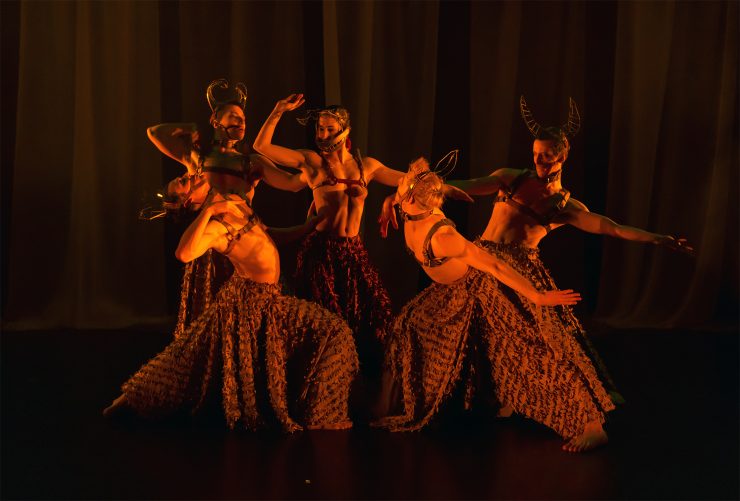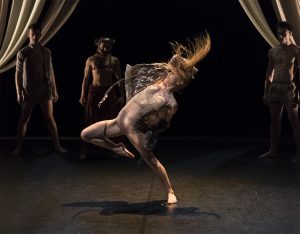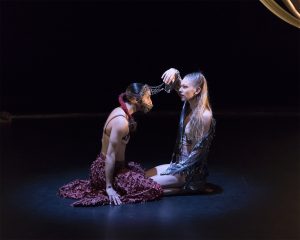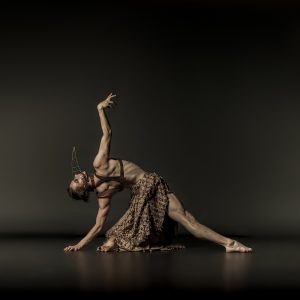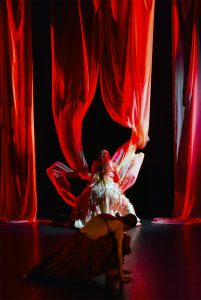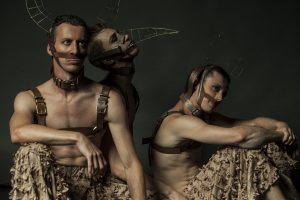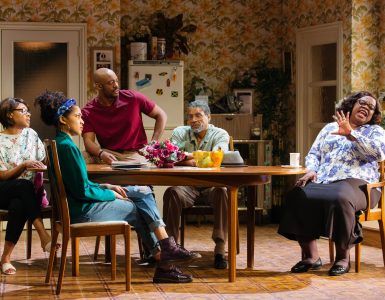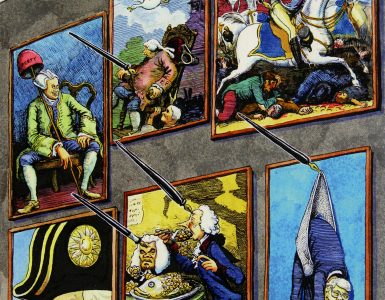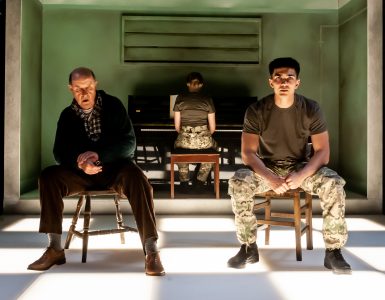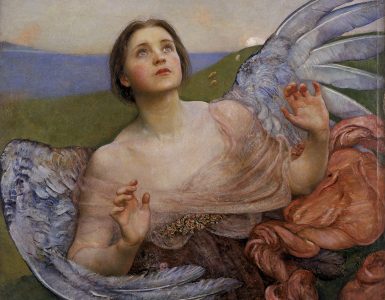DeNada Dance Theatre’s latest production, TORO: Beauty and the Bull, is a deliciously dark fairy tale-come-nightmare that explores queer sexualities and draws on fantasy, myth and camp culture.
In his programme notes, DeNada co-founder and choreographer Carlos Pons Guerra describes his piece, TORO: Beauty and the Bull:
In this reading of Beauty and the Beast, the beastly is the imposed guise of the oppressed: of women, homosexuals and subjected natives, strapped in leather harnesses and steel bondage, who nevertheless dance proudly and bravely like the animals in drag (or dragimals) that live in this production. Like all fairy stories, TORO is a cautionary tale, but in this case, one that cautions us against the men who have historically decided who the monster is.
Guerra’s work, with its layered exploration of sexualities and desires, and its celebratory infusion of drag and ‘vogue’ culture, references to Paris is Burning, Spanish-language torch song revivals of musical standards, and unabashed depictions of queer sexualities, questions how we designate the monstrous. In this fairy tale as nightmare, Guerra identifies the monster as the ‘white alpha (and often fascist) male’; the instigators in his drama and metonymy of colonization, rape culture, and homophobia. This is not a subtle moral and it does not need to be; nor is it a subtle piece, deliberately drawing as it does on elements of fantasy, myth and camp culture that delight in exaggeration.
In this, Sadler’s Wells’ Lilian Baylis Studio acts as the perfect performance space. The intimate theatre was styled as ‘a sex worker’s parlour, somewhere in colonised South America’ in Act 1 and the nightclubesque ‘circus sideshow, the desert’ in Act 2. As an audience, we were within feet of the dancers and able to see the muscles moving beneath their skin and the sweat on their bodies as they performed. This proximity also lent an edge to the piece as our experience at times seemed closer to that of the villains’ point of view: blurring the lines between the pleasure of sympathy with the beautiful ‘monsters’ and the thrill of voyeurism as we appreciate the dancers’ skill, even as they enact scenes of violence and atrocity.
The tenuousness of this difference between removed audience member and complicit customer became apparent from the moment we took our seats. Emma Walker, ‘The Girl’ or ‘Beauty’ of the title, lies, unmoving, unconscious, in the centre of stage. In a reversal of the sleeping princesses of fairy tales, she is not to be awakened with a kiss but has been drugged for the ease and pleasure of the men who take to the stage as the music starts. These men fight for possession of her unconscious body, kicking, pushing, and dragging her around, until she revives enough to wobble between them, unable to escape. Walker’s skill here is impressive, especially her control and her undeniable grace despite choreography which is meant to display a disconnect between intent and movement. Her limbs, neck and back seem untethered from herself, from a self, as she portrays physically the psychic disassociation of trauma. Throughout, her dancing changes dramatically with her state of mind and is relative to the degree of ownership she holds over her own subjectivity. This is echoed in the tone of the performance and the male dancer’s bodies, which transform when they take on different roles – and sexualities – and shift from the alpha males of scene 1 to the glorious ‘dragimals’ in the second act.
In contrast to The Girl’s pale, almost translucent suppleness, as the light catches her gauzy blouse and her seemingly softened and drugged limbs, Marivi Da Silva’s ‘Bull’ is iron-like and unbreakable. The violence against her adds a steeliness to her movements, an imposed immobility that contrasts with Walker’s melting passivity and to both dancers’ more graceful movements in Act 2. As the Bull, a hybrid creature in a bondage harness and muzzle, Da Silva has a metal bull’s head and a woman’s body. She is brought on stage as another conquest of the men who fight over The Girl, and for their purposes, The Bull is multiply ‘othered’ – feminized, dominated, colonised as the monstrous female; animal, queer and native of TORO’s mythology. Da Silva, the co-founder of DeNada, even while part of the narrative subjugation, commands the stage. She is an amazing dancer and presence, and the mobility and meaning in her movements is mirrored in her expressive eyes, though her face is mostly hidden behind the mask.
But this recognition of Da Silva’s power comes at the price of realising some of the more uncomfortable positions of power that are continuously staged in this world (on stage, and I would argue, off as well), which is still in thrall to patriarchal values. As the emblematic feminine (white, thin, blonde), The Girl is at first disturbed and repulsed by the darker, animal ‘other’, seeing the Bull initially as protector then as sexual initiation into queer desire. This replication of revulsion and attraction, played out to dangerous and insidious effect throughout TORO, is a trope well considered in Fanon’s, Said’s and Michelle Wallace’s work on race and sexuality. In her first physical encounter with Da Silva, Walker ‘rides’ her, an act that is mirrored in the ‘matadors’ torture, rape and murder of the powerful creatures, the ‘dragimals’ of the next act.
As I alluded to earlier, the audience’s power position in these dynamics, especially our relation to the performance and performers, also plays with these inescapable replications of patriarchal power structures. We are paying to watch and enjoy the bodies on the stage; our own place as consumers in a central London theatre refigures the colonial gaze that the ‘masculine’ characters, the brothel visitors, the ‘matadors’ and voyeurs represent, to less traumatic but still problematic degrees. Act 2 opens in the ‘circus’ night club of the joyous, sensual and fabulous dragimals and highlights this collision between the subjects lording their power over others as represented on stage, and the objectifying possibilities of our position as audience.
The male dancers who appear in the first act as brothel rapists are transformed in their presentation of an openly queer hybridity that breaks gender rules and biological restrictions. In the celebration of transitioning and transformed bodies of this ‘voguing’ sequence, the enemies from the previous act become our allies. This is a joyful escape from the oppressive and unsettling tone of the first act. In the final moments of this exuberant opening there is a deliberate pause for clapping that is included in the recorded music, which the audience immediately (and perhaps unconsciously) joins, making explicit this connection between the implied masculine colonial audience of johns and conquerors and the 100 people sitting in Sadler’s Wells on a Wednesday night. Thinking about the white, western colonial gaze turned onto (and turned on by) acts of violence and violation, I often wondered: where does this place us?
Questioning our position, and challenging some of these elements of violence in the performance, does not diminish my respect for the piece, the performers or Guerra’s message. His work proposes that art can make one angry or sad, and trigger something beyond enjoyment or pleasure in the beauty of the movement of his talented dancers: this is art that invigorates, troubles and defies. I loved the beginning of the second act and the sensuality and fluidity of movement as representative of the fluidity of sexualities and identities. This, and the following scene in which The Bull and The Girl join the dance, was a powerfully expressive and gorgeous moment. Here, the skill is recognisably graceful, flowing from body to body and in the bodies of each unique dancer, versus the unsettling tone and jerky movements in the scenes controlled by the masculine and plotted as rape.
Sexuality here becomes multiple and open to possibilities of love, respect and partnership(s) in the most hopeful expression of the queer as transformative. And it is this moment of hope that renders the remaining minutes of the dance so brutal. The somewhat bumbling and posturing ‘cocks’ of the first act return as matadors, the toxic masculine in full conquering mode. Here they are more assured, elegant, strong, and deadly. The simulated sex and acts of ‘rape’ that were (very uncomfortably) played a little lighter in the first act are unabashedly brutal in the climax and finale. No one is spared on stage, and no institution is left unscathed, including the ‘theatre’ as performative and consumer space, and marriage, imagined as literal rape and imprisonment. Walker is forced into a white wedding dress and tied to the walls of the stage, her gauzy ropes becoming tighter the more she struggles against them in trying to escape and in reaching for the Toro, who is dragged onto stage de-horned, depowered and dying.
I’m still thinking about some of elements, especially the elisions between queer and colonised experiences, and the qualification of ‘queer’ as mostly (or exclusively) male-focused homosexuality or transsexuality without full attention to the feminine as unique and differently-experienced. For all its positive messaging about expansive gender, sexuality and humanist possibilities, and though the piece is very queer and very feminist, it is also very, very dark. It pushes its audience, with its dancers, into uncomfortable and emotionally-unsafe positions, sometimes in ways that I don’t believe were acknowledged in its making or addressed in Guerra’s programme statement ‘Gods and Monsters’, and in the post-performance talk with the choreographer and the dancers.
But in one of my favorite moments of the evening, Da Silva, who is De Nada’s co-founder as well as the embodiment of the mutable, beautiful monstrous in this piece, was asked about her relation to the Toro in response to Guerra’s description of the Bull as an expression of his experience. Da Silva admitted that ‘I think something else just to please him’ – allowing her own interpretation to imbue those movements which most fully bring his vision to life, both acknowledging that choreography requires a ‘body’ to mediate the art and the meaning and that, of course, these ‘bodies’ – like the Bull, the Girl – have a consciousness behind and beyond the physical expressions or relations we witness and share. Even in the most respectful collaborations and the most joyful performances, we think or feel something else, hoping to be understood and realising the limits of understanding.
DeNada Dance Theatre’s TORO: Beauty and the Bull was performed at the Lilian Baylis Studio, Sadler’s Wells on the 25th & 26th April 2018. For more information on DeNada Dance Theatre click here: http://www.denada-dance.com

